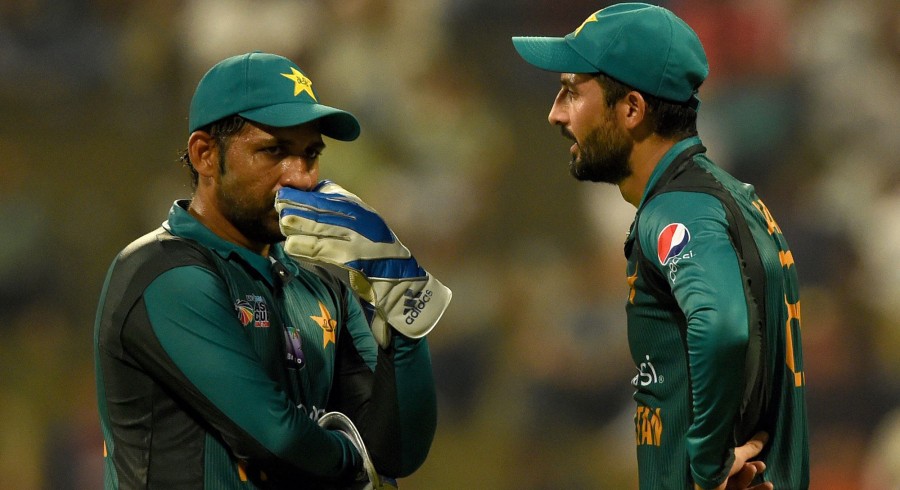Men in Green registered embarrassing exit after 37-run defeat against Bangladesh
 PHOTO: AFP
PHOTO: AFP
Pakistan is undoubtedly one of the most followed cricket team in the in the world, not because they are always amazing at what they do, but because there is never a certainty about what they will do.
It almost seems unbelievable that the team which looked so exhausted, so out of shape and so out of ideas in the Asia Cup was more or less the same unit that had beaten the likes of England, South Africa, India and Sri Lanka and lifted a major 50-over multi-nation trophy just 14 months ago — that too in English conditions.
When the tournament began, the Men in Green were labeled favourites ahead of defending champions India, especially in the absence of their star batsman and captain Virat Kohli, and frankly speaking, it made sense as well.
The team under Sarfraz Ahmed’s captaincy had won 16 out of 23 matches and looked solid in every department — a notion they had further fuelled.
In the first match of the tournament, the commentators were in awe of the team, lavishing them with praises for their talent, exuberance and modern game awareness.
But all that belief and energy faded away after the match against India on September 19 — that too in the blink of an eye.
Such drastic deterioration of a team that cricket pundits were claiming to become favourites for the next year’s World Cup made its captain looked demoralised, coach shell-shocked and fans scratching their head. So where did it all go wrong?
This much is evident that the team faltered in not one but all three departments, but the biggest crisis came in the form of planning, where the management was too rigid and unable to tweak their strategies.
It all started with team selection, where six pacers and only two spinners were selected for the tournament where other teams came in with at least four spinners in their squad.
Later on, it became clear that neither the captain nor the team management were ready to accept the reality that some players were just not good enough to be in that team in that very moment.
First on the list of non-performers was opener Fakhar Zaman, who finished the tournament with a mere 56 runs in five matches at an abysmal average of 11.20, which included two ducks as well.
His failure may come as a surprise to many but it was obvious after first few matches that the pitches were too slow for Zaman’s liking and they were bound to get slower with so much cricket played in the short span of such time.
But the team management kept backing him ahead of someone like left-handed opener Shan Masood, who was included in the squad ahead of seasoned campaigner Mohammad Hafeez because of his outstanding form in List A — but will return home without playing even a single match.
Then it was middle-order batsman Asif Ali, who finished the event with 77 runs in four innings at an average of 19.25.
It was quite appalling to see why the team management persisted with a player who had a List A average of 26.22 to bat at number six in the batting order when it was apparent that more than one batsman were struggling to find their form.
The decision seems more questionable when you have someone like Haris Sohail sitting in the wings and boasting an average of over 42 in 25 matches with nine half-centuries to his name in international cricket.
Then it was captain Sarfraz, who was not sure about his best batting position before the tournament started, and it seems that he is still not sure of his best number in the batting order.
In the bowling department, the same mistakes were repeated time and again. Reliance on out-of-form pacer Mohammad Amir was bewildering, especially considering that he had just three wickets in seven matches before the Asia Cup.
The left-armer finished the tournament wicketless, but played three out of five matches, two of which were against India and on both the occasions, he looked a shadow of the bowler he was back in the ICC Champions Trophy final.
Ignorance of pacer Junaid Khan was alarming as well, as not only he claimed best figure in the tournament by any Pakistan bowler, but before Asia Cup, he had the best economy-rate out of 4.02 amongst all the bowlers in the team in the last 12 months.
Before Sarfraz became the leader of the team, it was too many changes that was the cause of trouble, but now it seems the other way around.
Surely Sarfraz would have learned while playing under previous captains that a lack of stability might spoil the party and therefore, he is trying not to repeat the same mistake. But that does not necessarily mean an extreme approach in the opposite direction is needed.
Teams like England, India and New Zealand thrive in different conditions by playing players who are best suited for those conditions; same should be Pakistan’s approach going forward.
There is pain, there is disappointment and players will be feeling it more than anyone else. But it is no time to panic. It is time to do the right thing. It is time to stay united and start road to recovery and glory.